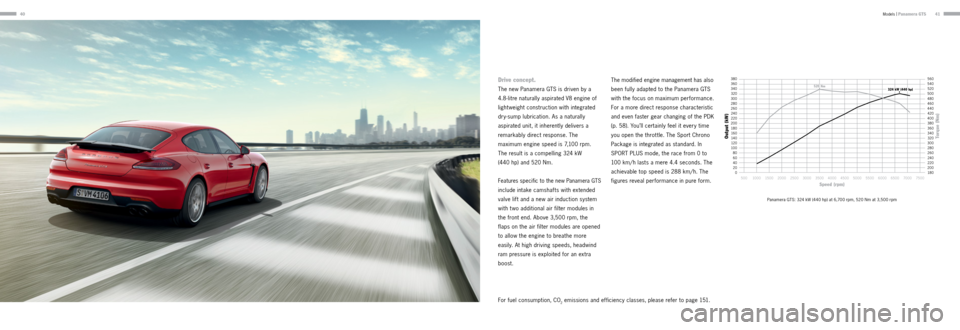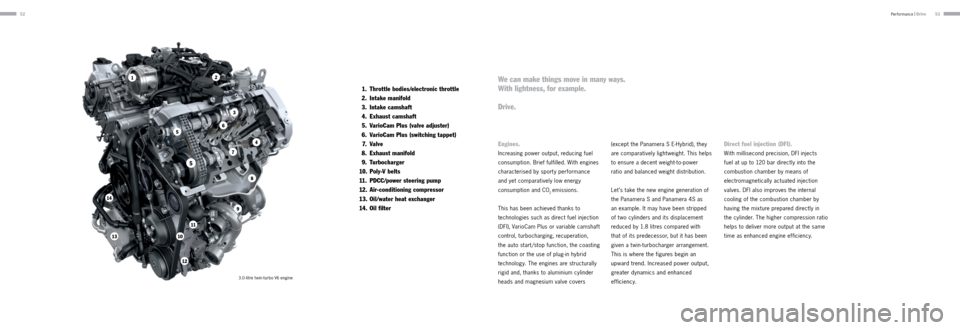fuel filter PORSCHE PANAMERA 2013 1.G Information Manual
[x] Cancel search | Manufacturer: PORSCHE, Model Year: 2013, Model line: PANAMERA, Model: PORSCHE PANAMERA 2013 1.GPages: 78, PDF Size: 13.39 MB
Page 20 of 78

4041
Drive concept.
The new Panamera GTS is driven by a
4.8-litre naturally aspirated V8 engine of
lightweight construction with integrated
dry-sump lubrication. As a naturally
aspirated unit, it inherently delivers a
remarkably direct response. The
maximum engine speed is 7,100 rpm.
The result is a compelling 324 kW
(440 hp) and 520 Nm.
Features specific to the new Panamera GTS
include intake camshafts with extended
valve lift and a new air induc tion system
with t wo additional air filter modules in
the front end. Above 3,500 rpm, the
flaps on the air filter modules are opened
to allow the engine to breathe more
easily. At high driving speeds, headwind
ram pressure is exploited for an extra
boost.
The modified engine management has also
been fully adapted to the Panamera GTS
with the focus on maximum performance.
For a more direct response characteristic
and even faster gear changing of the PDK
(p. 58). You’ll certainly feel it every time
you open the throt tle. The Sport Chrono
Package is integrated as standard. In
SPORT PLUS mode, the race from 0 to
100 km/ h lasts a mere 4.4 seconds. The
achievable top speed is 288 km/ h. The
figures reveal performance in pure form.
For fuel consumption, CO
2 emissions and efficiency classes, please refer to page 151.
Models |
Panamera GTS
Panamera GTS: 324 kW (440 hp) at 6,700 rpm, 520 Nm at 3,500 rpm
380
360
340 320
300 280260 240
220
200 18 016 0
14 012 0
10 0 8060
40
20
0
500 1000 15 0 02000 25003000 35004000 45005000 55006000 65007000 7500560
540
520
500
480 460
440 420
400 380360
340 320
300 280260 240
220
200 18 0
Torque (Nm)
Output (kW)
Speed (rpm)
520 Nm324 kW (440 hp)
Page 26 of 78

5
12
3
4
56
7
8
9
10
11
12
13
14
5253
Engines.
Increasing power output, reducing fuel
consumption. Brief fulfilled. With engines
characterised by sporty performance
and yet comparatively low energy
consumption and CO
2 emissions.
This has been achieved thanks to
technologies such as direct fuel injection
(DFI), VarioCam Plus or variable camshaft
control, turbocharging, recuperation,
the auto start/stop function, the coasting
function or the use of plug-in hybrid
technology. The engines are structurally
rigid and, thanks to aluminium cylinder
heads and magnesium valve covers (except the Panamera S E-Hybrid), they
are comparatively light weight. This helps
to ensure a decent weight-to -power
ratio and balanced weight distribution.
Let’s take the new engine generation of
the Panamera S and Panamera 4S as
an example. It may have been stripped
of t wo cylinders and its displacement
reduced by 1.8 litres compared with
that of its predecessor, but it has been
given a twin-turbocharger arrangement.
This is where the figures begin an
upward trend. Increased power output,
greater dynamics and enhanced
e f f ici e n cy.
Direct fuel injection (DFI).
With millisecond precision, DFI injects
fuel at up to 120 bar directly into the
combustion chamber by means of
electromagnetically actuated injection
valves. DFI also improves the internal
cooling of the combustion chamber by
having the mixture prepared directly in
the cylinder. The higher compression ratio
helps to deliver more output at the same
time as enhanced engine efficiency.
3.0-litre twin-turbo V6 engine
We can make things move in many ways.
With lightness, for example.
Drive.
Performance |
Drive
1. Throttle bodies/electronic throttle
2. Intake manifold
3. Intake camshaft
4. Exhaust camshaft
5. VarioCam Plus (valve adjuster)
6. VarioCam Plus (switching tappet)
7. V a l v e
8. Exhaust manifold
9. Turbocharger
10. Poly-V belts
11. PDCC/power steering pump
12. Air-conditioning compressor
13. Oil/water heat exchanger
14. Oil filter